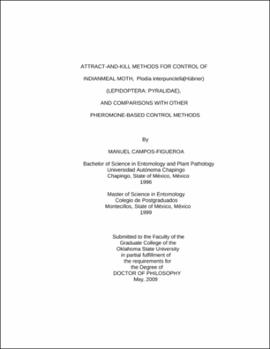| dc.contributor.advisor | Phillips, Thomas W. | |
| dc.contributor.author | Campos-Figueroa, Manuel | |
| dc.date.accessioned | 2013-11-26T08:23:43Z | |
| dc.date.available | 2013-11-26T08:23:43Z | |
| dc.date.issued | 2009-05 | |
| dc.identifier.uri | https://hdl.handle.net/11244/6729 | |
| dc.description.abstract | Scope and Method of Study: The approaches were to test attract-and-kill formulations in laboratory conditions, simulated warehouses and commercial establishments to control Plodia interpunctella populations. | |
| dc.description.abstract | Findings and Conclusions: Adult males of Plodia interpunctella were impacted by pyrethroids and naturally derived Pyrethrins in contact toxicity tests, where mortality was more than 70%. Permethrin might be an alternative to be used in an attract-and-kill formulation for up to eight weeks. Is has adequate residual active ingredient, and adequate material and doses can be sprayed on to plastic-coated paper, bare metal, or bare plastic. The dispenser of pheromone is important in the attraction of adult males. An optimal release gradient will attract males; otherwise improper gradients will repel or do not elicit any attraction. Wax panels and plastic cylinders, both with 6.0% active ingredient (permethrin and cyfluthrin, respectively), that are deployed with a Biolure strips suppressed adult populations in wind tunnel experiments. Similar impact was demonstrated in simulated warehouses, except that cyfluthrin was used at 2.0% active ingredient. In 2005, a field experiment was conducted in commercial establishments, and wax panels with 6.0% permethrin that were deployed with Biolures' significantly suppressed P. interpunctella populations. In 2006, pheromone-based methods were tested in commercial establishments. Among methods tested, the attract-and-kill formulation using 0.08% deltamethrin sprayed on plastic-coated paper. This method was not as effective as the wax panels utilized during the previous year. Mating disruption method with Biolures' only was as equally as effective as mass-trapping. Either of these methods can be used by pest control operators if applied at the proper concentration and formulation. | |
| dc.format | application/pdf | |
| dc.language | en_US | |
| dc.rights | Copyright is held by the author who has granted the Oklahoma State University Library the non-exclusive right to share this material in its institutional repository. Contact Digital Library Services at lib-dls@okstate.edu or 405-744-9161 for the permission policy on the use, reproduction or distribution of this material. | |
| dc.title | Attract-and-kill methods for control of indianmeal moth, Plodia interpunctella (Hubner) (Lepidoptera: Pyralidae), and comparisons with other pheromone-based control methods | |
| dc.contributor.committeeMember | Kard, Bradford M. | |
| dc.contributor.committeeMember | Payton, Mark E. | |
| dc.contributor.committeeMember | Dillwith, Jack W. | |
| osu.filename | Campos_okstate_0664D_10125 | |
| osu.accesstype | Open Access | |
| dc.type.genre | Dissertation | |
| dc.type.material | Text | |
| dc.subject.keywords | attract-and-kill | |
| dc.subject.keywords | insecticide | |
| dc.subject.keywords | pheromone | |
| dc.subject.keywords | plodia | |
| dc.subject.keywords | semiochemicals | |
| dc.subject.keywords | stored-products | |
| thesis.degree.discipline | Entomology | |
| thesis.degree.grantor | Oklahoma State University | |
